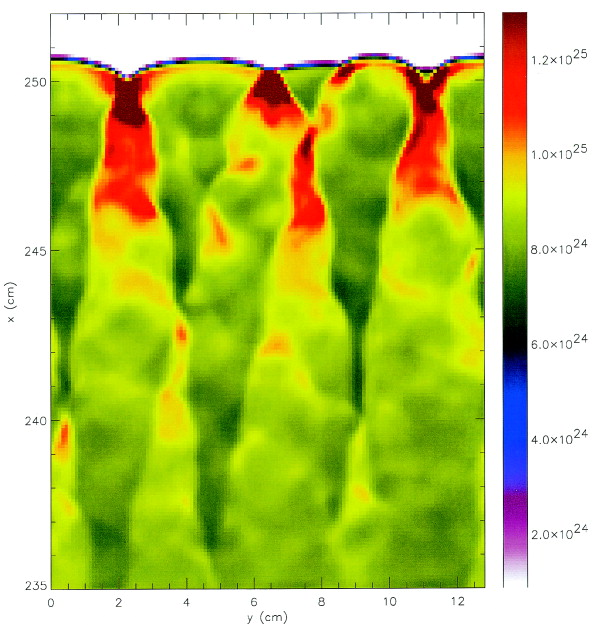Next: 35.6 RadTrans Test Problems Up: 35. The Supplied Test Previous: 35.4 Particles Test Problems Contents Index
The Cellular Nuclear Burning problem is used primarily to test the function of the Burn simulation unit. The problem exhibits regular steady-state behavior and is based on one-dimensional models described by Chappman (1899) and Jouguet (1905) and Zel'dovich (Ostriker 1992), von Neumann (1942), and Doring (1943). This problem is solved in two dimensions. A complete description of the problem can be found in a recent paper by Timmes, Zingale et al(2000).
A 13 isotope ![]() -chain plus heavy-ion reaction network is used
in the calculations. A definition of what we mean by an
-chain plus heavy-ion reaction network is used
in the calculations. A definition of what we mean by an
![]() -chain reaction network is prudent. A strict
-chain reaction network is prudent. A strict ![]() -chain
reaction network is only composed of (
-chain
reaction network is only composed of (![]() ,
,![]() ) and
(
) and
(![]() ,
,![]() ) links among the 13 isotopes
) links among the 13 isotopes ![]() He,
He, ![]() C,
C,
![]() O,
O, ![]() Ne,
Ne, ![]() Mg,
Mg, ![]() Si,
Si, ![]() S,
S, ![]() Ar,
Ar,
![]() Ca,
Ca, ![]() Ti,
Ti, ![]() Cr,
Cr, ![]() Fe, and
Fe, and ![]() Ni. It is
essential, however, to include (
Ni. It is
essential, however, to include (![]() ,p)(p,
,p)(p,![]() ) and
(
) and
(![]() ,p)(p,
,p)(p,![]() ) links in order to obtain reasonably accurate
energy generation rates and abundance levels when the temperature
exceeds
) links in order to obtain reasonably accurate
energy generation rates and abundance levels when the temperature
exceeds ![]() 2.5
2.5![]() 10
10![]() K. At these elevated temperatures
the flows through the (
K. At these elevated temperatures
the flows through the (![]() ,p)(p,
,p)(p,![]() ) sequences are faster
than the flows through the (
) sequences are faster
than the flows through the (![]() ,
,![]() ) channels. An
(
) channels. An
(![]() ,p)(p,
,p)(p,![]() ) sequence is, effectively, an
(
) sequence is, effectively, an
(![]() ,
,![]() ) reaction through an intermediate isotope. In our
) reaction through an intermediate isotope. In our
![]() -chain reaction network, we include 8 (
-chain reaction network, we include 8 (![]() ,p)(p,
,p)(p,![]() )
sequences plus the corresponding inverse sequences through the
intermediate isotopes
)
sequences plus the corresponding inverse sequences through the
intermediate isotopes ![]() Al,
Al, ![]() P,
P, ![]() Cl,
Cl, ![]() K,
K,
![]() Sc,
Sc, ![]() V,
V, ![]() Mn, and
Mn, and ![]() Co by assuming steady state
proton flows. The two-dimensional calculations are performed in a planar geometry of size 256.0 cm by 25.0 cm.
The
initial conditions consist of a constant density of 10
Co by assuming steady state
proton flows. The two-dimensional calculations are performed in a planar geometry of size 256.0 cm by 25.0 cm.
The
initial conditions consist of a constant density of 10![]() g
cm
g
cm![]() , temperature of 2
, temperature of 2![]() 10
10![]() K, composition of pure
carbon X(
K, composition of pure
carbon X(![]() C)=1, and material velocity of
C)=1, and material velocity of
![]() = 0 cm
s
= 0 cm
s![]() . Near the x=0 boundary the initial conditions are perturbed to the
values given by the appropriate Chapman-Jouguet solution: a density of
4.236
. Near the x=0 boundary the initial conditions are perturbed to the
values given by the appropriate Chapman-Jouguet solution: a density of
4.236![]() 10
10![]() g cm
g cm![]() , temperature of 4.423
, temperature of 4.423![]() 10
10![]() K,
and material velocity of
K,
and material velocity of ![]() = 2.876
= 2.876![]() 10
10![]() cm s
cm s![]() .
Choosing different values
or different extents of the perturbation simply change how long it
takes for the initial conditions to achieve a near ZND state, as well as
the block structure of the mesh. Each block contains 8 grid points in the
x-direction, and 8 grid points in the y-direction. The default parameters for
cellular burning are given in Table 35.16.
.
Choosing different values
or different extents of the perturbation simply change how long it
takes for the initial conditions to achieve a near ZND state, as well as
the block structure of the mesh. Each block contains 8 grid points in the
x-direction, and 8 grid points in the y-direction. The default parameters for
cellular burning are given in Table 35.16.
The initial conditions and perturbation given above ignite the nuclear
fuel, accelerate the material, and produce an over-driven detonation
that propagates along the x-axis. The initially over-driven
detonation is damped to a near ZND state on short time-scale. After
some time, which depends on the spatial resolution and boundary
conditions, longitudinal instabilities in the density cause the planar
detonation to evolve into a complex, time-dependent structure. Figure 35.70 shows the pressure field of the detonation after
1.26![]() 10
10![]() s. The interacting transverse wave
structures are particularly vivid, and extend about 25 cm behind the
shock front. Figure 35.71 shows a close up of this traverse
wave region. Periodic boundary conditions are used at the walls parallel to
the y-axis while reflecting boundary conditions were used for the walls
parallel to the x-axis.
s. The interacting transverse wave
structures are particularly vivid, and extend about 25 cm behind the
shock front. Figure 35.71 shows a close up of this traverse
wave region. Periodic boundary conditions are used at the walls parallel to
the y-axis while reflecting boundary conditions were used for the walls
parallel to the x-axis.

|